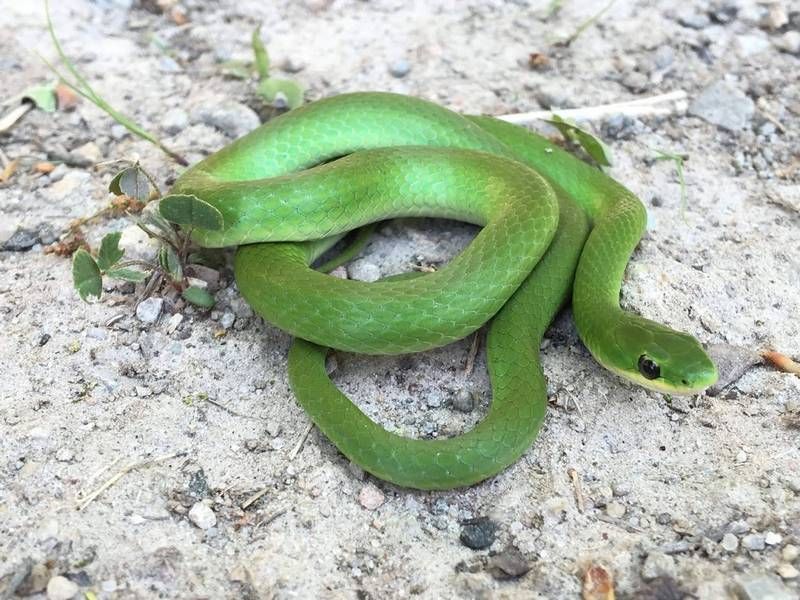Matt Ellerbeck - Snake Conservationist | Apr 28, 2021
The Frontenac area is home to a wide variety of wildlife. This includes ten different species of snakes. Although the thought of coming across a snake terrifies most people, this fear is not warranted. All of the snakes that are found within the region are completely harmless. None are venomous. In fact, most of the snakes in the area are quite small.
These smaller forms include the Ring-Necked Snake (Diadophis punctatus), the Smooth Green Snake (Opheodrys vernalis), the Red-bellied Snake (Storeria occipitomaculata), the Dekay's Brown Snake (Storeria dekayi), the semi-aquatic Ribbon Snake (Thamnophis sauritus) and the familiar Garter Snake (Thamnophis sirtalis).
All of these snakes are beneficial to people as they act as a form of pest control, preying on a variety of invertebrates. This includes snails and slugs which makes them a great aid to gardeners.
Some of the larger species in the area are plagued by a variety of stigmas and misconceptions. The Eastern Milk Snake (Lampropeltis triangulum) is covered with saddles that makes it superficially resemble a rattlesnake. Despite not having an actual rattle, Milk Snakes will vibrate their tails rapidly when they feel scared. If the tail is vibrating up against dry leaves or pebbles it will create a buzzing sound. This further perpetuates the myth that Milk Snakes are venomous.
Juvenile Water Snakes (Nerodia sipedon) and Gray Rat Snakes - sometimes called Black Rat Snakes (Pantherophis spiloides), both look similar to the Milk Snake and may also suffer the same persecution. Water Snakes can grown between 3-4 feet long and be quite heavy-bodied. The Rat Snakes are the largest species within the region (and the largest in Ontario), growing over 6 feet long. Milk Snakes and Rat Snakes eat rodents, so again are a good form of pest control.
Sadly, many snakes are intentionally killed by fearful individuals who think that these reptiles are aggressive or dangerous.
However, snakes do not look for people to attack or bite. When a person comes in contact with a snake, the animal will usually try to flee the area and find shelter. If the snake doesn't do this, it may just stay perfectly still to try to blend in with the surroundings.
Even if the snake is captured, it may still not resort to biting. The snake has several harmless tactics it can resort to as an alternative to biting. The snake may hiss, make mock strikes with a closed mouth, or flail around to try and escape. This is the snake's way of saying just leave me alone! An account of the true nature of snakes can be found in a study done by University of Georgia Professor Dr. Whit Gibbons. The following excerpt from Dr. Gibbons' study speaks for itself:
''All the snake species tested have had the same initial response to human presence. If given the opportunity, they escape--down a hole, under a ledge, or in the case of cottonmouth snakes, into the water. Escape is even the standard behaviors of enormous diamondback rattlesnakes, which will immediately disappear if they have enough warning before they think a person can reach them. The snakes just want us to leave them alone.''
Snake bites on humans usually only occur when someone is deliberately trying to provoke or harm a snake, and the animal bites purely in self-defense. According to NC State University, almost 80% of snake bites happen when someone is trying to capture or kill the snake. All these facts show that snakes are not aggressive or evil animals. If you provoke and capture a wild animal, what can you expect but be bitten since the animal is going to try to defend itself?
Emergency Room (ER) Nurse, Lisa Deanne Doss, (based in the Southern United States) stated in 2019: ''In a 10 year period, 95% of all the snakebites that I have seen have been the result of someone trying to kill the snake. The other 5% were from people who accidentally stepped on them while wearing sandals when it was getting dark outside.''
Edward R. Ricciuti’s The Snake Almanac (Lyons Press 2001), states that ''venomous snakes do not look for people to bite'' and Mark O’ Shea’s Venomous Snakes of the World (Princeton University Press 2005), proclaims ''that people must realize that snakes are not out to bite them but prefer to be left alone.''
Therefore, to be safe around snakes, individuals should never attempt to capture, kill, or handle these animals. People should also maintain their distance. But in the Frontenac Area the most one could do is give a little nip... such nips are easily avoided. So be not afraid of the snakes and leave them be.
Image Gallery
-
 Click to open image!
Click to open image!
Click to open image!
Click to open image!
-
 Click to open image!
Click to open image!
Click to open image!
Click to open image!
-
 Click to open image!
Click to open image!
Click to open image!
Click to open image!
https://www.frontenacnews.ca/item/14793-be-not-afraid-the-snakes-of-the-frontenac-area-are-harmless#sigProId8cc009d4b7
More Stories
- Harrowsmith Public School and the Magic of Theatre
- You’re a Good Man Charlie Brown – a school wide effort at SHS
- Leadership From Within
- New Bulk Water Station in Sydenham
- Frontenac County Council looks at Healthcare Recruitment
- Good Turn Out Maple Fest Despite Rain
- Future looking brighter for Denbigh Fire Department says Chief
- Local Favourites featured at 2nd Annual SF Music Festival
- Perth Festival of the Maples, Saturday, April 27
- South Frontenac Council

